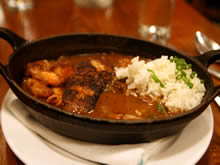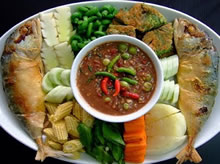| BlueSky Business Aviation News | ||||||||||||||||||||||||||
| . | ||||||||||||||||||||||||||
We all get stuck in a catering rut; I know I do. I spend my spring fever - and my fall and winter hibernation - looking for new flavors and seasonal foods to add to the menu. If I'm bored with the usual aviation food, then you probably are as well. If you feel that your daily procurement of catering requests have become mundane and lack a bit of luster, you can take that everyday mundane and turn it to a truly inspired breath of fresh air on board. You may find that your newly inspired menu selections bring countless amounts of positive feedback. Now, let’s get started. You can apply any of these spice combinations to most all foods and even some desserts. However, you shouldn't mix spices from different regions in the same meal. Use the new flavor combinations on one menu item at a time to ensure that the item remains distinctive. Cajun
Our own Cajun Chef Dan made these concoctions famous by rubbing them on fish and adding them liberally to gumbos ( imagine something so wonderful and chunky and filled with layers of flavors that contained so much passion) , but you can also sprinkle them on anything from potatoes to salad. Cajun seasoning will provide a wakeup call for your passengers and flight crew with spicy heat. French- Herbs de Provence Next consider the spices and food commonly found in French cuisine. Where shall I start? I will focus on specifically one . . . Herbs de Provence. This mixture is the signature of southern French cooking. The climate of Provence makes it an ideal garden for growing these herbs, which are usually used fresh. These herbs can be mixed with pepper, garlic, and other spices to make a rub for fish or meat. They can also be added to stews such as the popular vegetable stew called ratatouille. I am talking about the food rather than the hit movie! Ratatouille was a poor man’s stew originating from the Nice area of France. It can be served as a standalone dish or side. Ratatouille’s base is tomatoes, with the addition of onions, peppers, zucchini, eggplant, garlic, herbs and spices. Ingredients found in the Herbs de Provence include chervil, tarragon, savory, marjoram, rosemary, thyme, fennel. Up your menu a bit with this spice blend, take your catering to new heights with classic French Haute Cuisine (literally ' high food') - also known as Grand Cuisine, this is the food prepared at high end establishment, were presentation counts just as much as the food itself. Portions are sized inversely to plate diameter. The French have led our food styles for centuries ; allow them to show you a glorious way out of your catering rut. Your flight meals will be a bit of Heaven. Mediterranean
Vegetables appear in dishes in a variety of forms: baked, roasted, sautéed grilled, puréed, and served fresh in salads. Just thinking of the possibilities is exciting, isn’t it? Olive trees are abundant in this region and thus provide a major component of the meal structure. Both the oil and the fruit of the tree provide delicious ingredients for the staple recipes of the area. The olives themselves add a forceful, fermented, sharpness which excites our passengers and flight crews' taste buds. Because Mediterranean cuisine is a blend of the cultures of the region, rather than of one country, its diversity also add to its interest. The depth of the deep blue Mediterranean Sea yields an array of seafood which is widely used in the regional dishes. Spreads for bread, such as tapenade, are common all across Italy, Greece, Turkey, and other Mediterranean cultures. They often contain capers, buds of perennial plants that are picked before they're ripe, then cured in brine. Because they can't be dried, capers weren't widely traded along spice routes, so their use in a tapenade is indicative of this particular regional flavor. Again, due to the perfect climate, the use of fresh herbs characterizes Mediterranean cuisine. Create this flavor profile by adding fresh and dried herbs such as basil, oregano, rosemary, marjoram, parsley, mint, thyme, dill, saffron, cilantro, red chili, and tarragon, as well as garlic, dried tomatoes, a fresh squeezed of lemon juice, olives, olive oil or bit of fennel. Imagine what you can create with this array of flavors. Top chicken or fish with - or simply add a tapenade and bread, fresh baked of course, to the flight. WOW! Indian
Did I have a lesson to learn! As I give you a few spices that are commonly used in Indian cuisine, the blends are personal and will vary from food source to food source. You should ask your catering source for their combinations to recreate robust flavor associated with Indian cuisine. The sauces found in Indian cuisine are perfect for aviation. They are bold and will add the level of moisture needed to reheat on board. Be sure to treat these sauced dishes as casseroles and reheat using a temperature probe to check the internal temperature for food safety. Remember the ingredients vary from region to region, north to south. This is a basic mixture below, but you could also add or substitute many spices, like cinnamon, mace, nutmeg, or cloves depending on your personal preferences. Spices frequently found in Indian blends are red chilies, coriander seed, cumin seed, black mustard seed, black peppercorn, fenugreek seed, curry or bay leaves, ginger, and turmeric. Enjoy exploring the use of Indian spice blends for your next catering order. Thai
Since harmony is the guiding principal behind Thai food I will mention Nam prik or "chili sauce." We find a great many variations and uses of nam prik in Thai preparations, and it is often flavored to go with a specific food, like chicken, fish, or vegetables. Spices that flavor the sauce vary from region to region throughout the country. Spices characteristic to Thai cuisine commonly seen are vinegar, sugar, chilies, lime juice, and garlic. Other things to try adding are coriander, tamarind, dried fish or fish sauce, fruits, and nuts. A typical meal might include a clear soup (perhaps bitter melons stuffed with minced pork), a steamed dish (mussels in curry sauce), a fried dish (fish with ginger), a hot salad (beef slices on a bed of lettuce, onions, chillies, mint and lemon juice) and a variety of sauces into which food is dipped. This would be followed by sweet desserts or fresh fruits such as mangoes, durian, jackfruit, papaya, grapes or melon. If you choose to add Thai spices to your inflight meals, be creative and continue the feel of harmony in colors, flavors and other seasoning. China
The 'harmony of five flavors' serves to realize direct gustatory enjoyment first, which at the same time provides important regulative and healthcare functions to human body. According to traditional Chinese medicine, the pungent taste can diffuse evil influence, moisten dryness and promote qi and blood circulation, which can be used to cure cold, aching bones and muscles as well as kidney deficiency; the sweet taste can be tonifying, alleviatory and can improve mood, for example, honey and red jujube are nutrients for patients; the sour taste can astringe the intestines, stop diarrhea, promote salivation and quench thirst, and the effect of folk secret recipes such as using fumigated vinegar to prevent cold and boiled vinegar egg to cure cough have been proven by modern medicine; the bitter taste can clear away heat, improve eyesight and remove toxic substances. The harmony of five flavors is a prerequisite for health and prolonged life. “ I have always been told that I should learn one new thing each day. I realized that this was additional new information for me to add to my trivia collection. A staple I found in Chinese cooking during my spice profile research is a technique called "flavor potting". To achieve this flavor potting, meat is steeped in a rich sauce and cooked for long hours. The spices frequently used in flavor potting are the most commonly used are five-spice powder, and encompass five flavors - sweet, sour, bitter, pungent, and salty. Some recipes use them in equal proportions such as fennel seeds, star anise, cinnamon stick, peppercorns, and cloves. With these common spices of various cuisines of the world be creative. You can now suggest that you have Cajun baked chicken or chicken prepared with Herbs de Provence seasoning in place of your regular standby of grilled chicken. Create a Thai meal of harmony with shreds of chicken combined with a Nam prik (chili sauce) or a five spice seasoned Chinese chicken. Think outside the box when planning your inflight meals simply by changing your spice profile . . . and have fun experimenting.
Let me introduce myself . . . My name is Paula Kraft and I am founder and President of Tastefully Yours Catering, an aviation specific caterer, located in Atlanta, Georgia for over 35 years.
Currently I am an active member of the NBAA Flight Attendant Committee Advisory Board and the NBAA International Flight Attendant Committee, Women in Corporate Aviation, Women in Aviation International, National Association of Catering Executives, International Flight Catering Association, the International Food Service Association and the International Caterer’s Association. I have coordinated training programs and clinics for NBAA, EBAA and BA-Meetup conference attendees for over 10 years, created mentoring programs for caterers and flight attendants to broaden their aviation culinary skills, and to assist them in adapting to the unique challenges and constraints found in catering for general aviation. I recognize the need for training and have worked closely with flight departments, flight crews, schedulers and customer service reps at the FBOs to ensure that catering specific training provides information and skills necessary to reduce risk while assisting them in their job duties that include safe food handling, catering security, accurate transmission of food orders, and safe food production, packaging and delivery. I fell into aviation catering quite by accident. I was the in-house caterer and bakery supplier for Macy’s department stores in Atlanta when catering was ordered for a Macy’s customer which was soon to change my life. After the client enjoyed the catering provided, I was summoned to the client’s corporate office to provide several of the items delivered through Macy’s to the executive dining room. Within a week, I was providing food for the flight department and my first order was for the President of a foreign country (as I was too be told soon after). So, here I am, some 35 years later, still loving every minute of every day in aviation catering.
|
||||||||||||||||||||||||||







